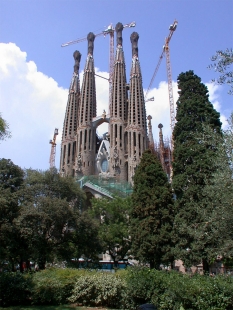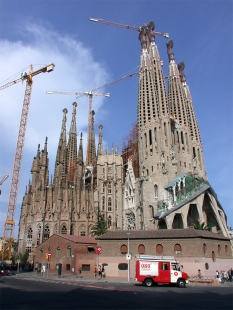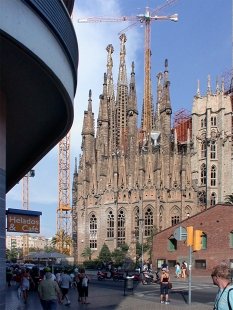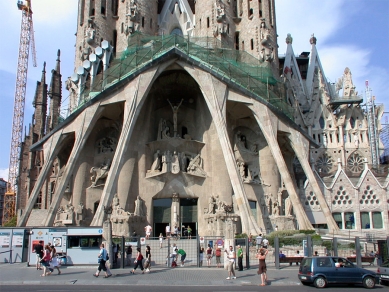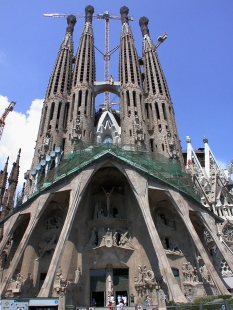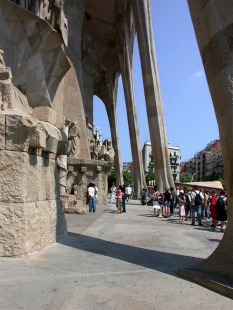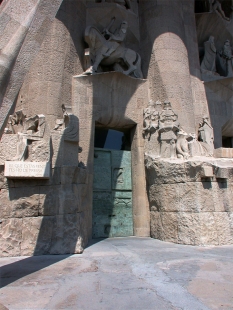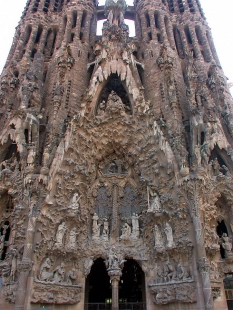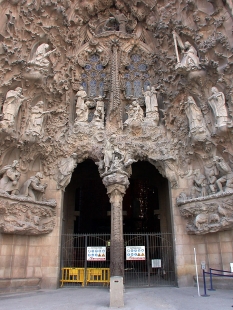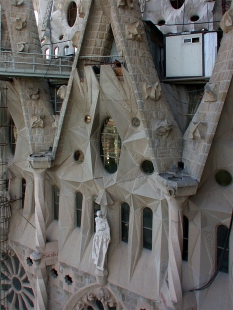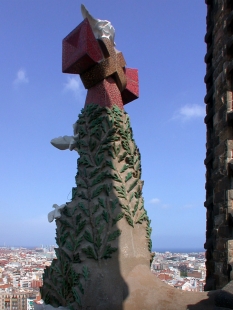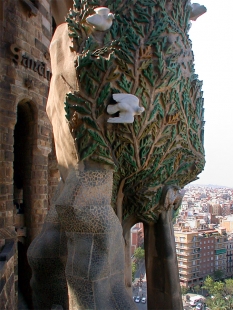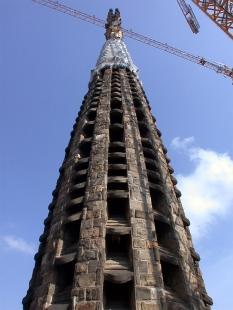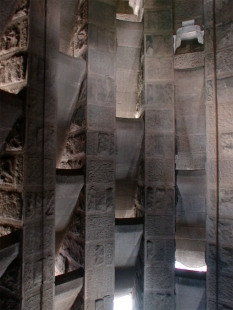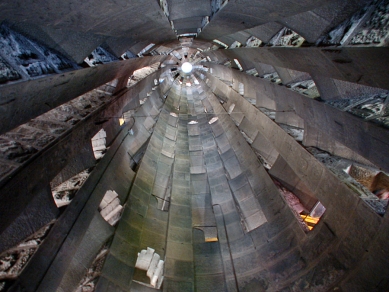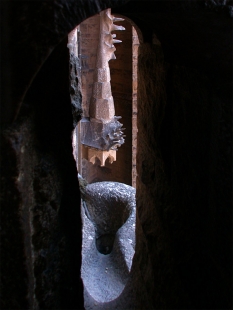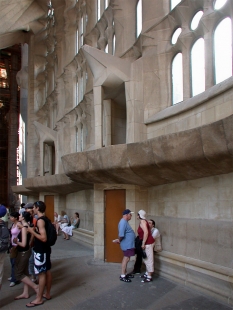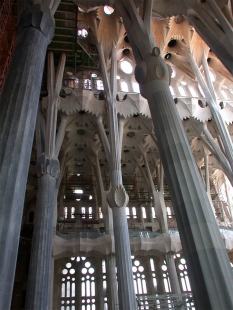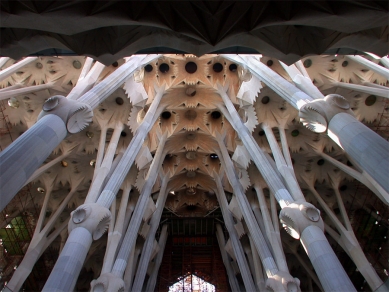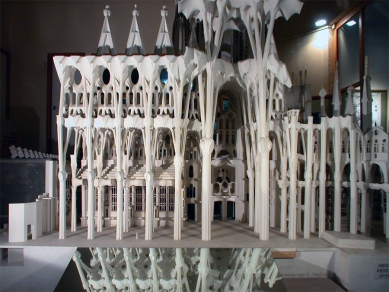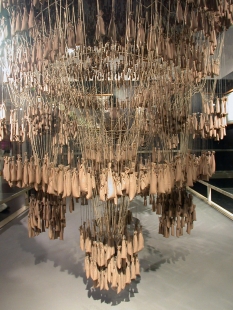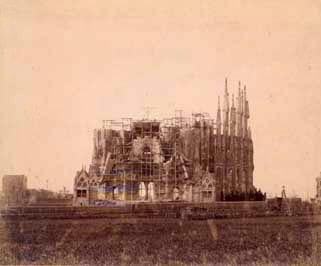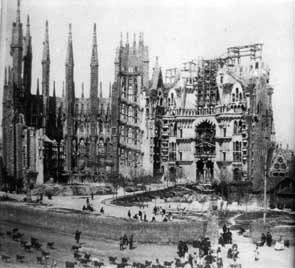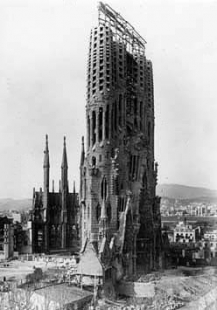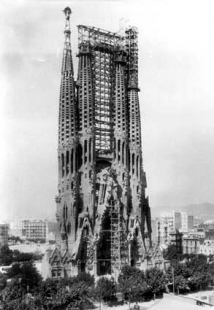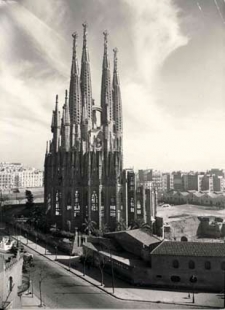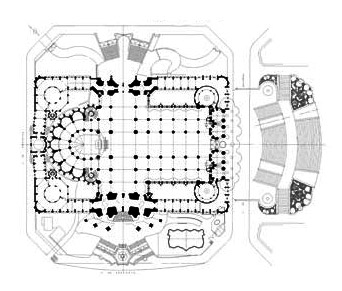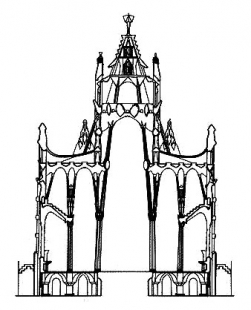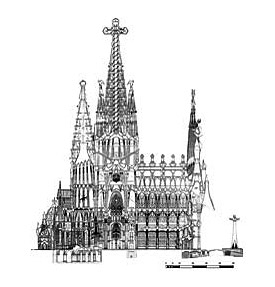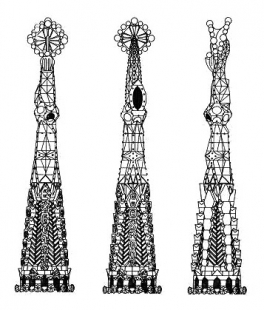
The Sacred Family

The Sagrada Familia (in Czech, the Temple of Atonement dedicated to the Holy Family) is located on the eastern coast of Spain in Barcelona. Construction began in 1884 and continues to this day. The temple is the main work of the famous architect Antoni Gaudí. This extraordinary building was intended to inspire a return to the teachings of the Roman Catholic Church.
Gaudí's work shows influences of Moorish architecture. He was interested in Art Nouveau, but his approach to architecture is very individual and unconventional. Instead of precise plans, he created blurred sketches, often visiting the construction site to observe every detail so he could modify them as needed. Gaudí took over the Sagrada Familia project at a very early stage (in 1891) and devoted a lot of energy to it. However, he died in 1926, and it proved impossible to continue the construction in his spirit. It is presumed that Gaudí would not have stuck to the coloring of natural stone; he loved colors, and many of his works show excessive use of various color tones.
Gaudí intended to build the Sagrada Familia as the "last great sanctuary of Christianity," and therefore this cathedral is very rich in Christian symbols. One of the most thought-out features is the 18 towers, which represent the 12 apostles, the 4 evangelists, the Virgin Mary, and the tallest tower representing Jesus Christ. The towers representing the evangelists will one day be complemented by statues depicting the traditional symbols of these saints: a bull (St. Luke), an angel (St. Matthew), an eagle (St. John), and a lion (St. Mark). The central tower of Jesus Christ will be topped with a huge cross.
It is known that Gaudí also wanted to equip the cathedral with three monumental façades: Nativity, Passion, and Resurrection, each of which was to have its own 4 towers. By 1935, when construction was interrupted, only the eastern façade - Nativity - was completed. On the tops of its towers are various geometric shapes - in their construction, Gaudí was probably influenced by cubism.
The decoration also includes many liturgical texts such as "Hosanna," "Excelsis," or "Sanctus"; on the large doors of the Nativity façade, we can read various texts from the Bible in different languages, including Catalan.
There have been several discussions about the completion of the church. Some say that finishing it would be like giving arms to the Venus of Milos, while others would agree to the completion. Recently, a completely new façade representing the Passion of Christ was built, which, however, is in places very different from Gaudí's work and his idea. The overall completion of the cathedral is planned for 2026 – the 100th anniversary of Antoni Gaudí's death.
In 2008, Gaudí's Sagrada Familia will open for services. This will conclude the unique saga of architecture that began 124 years ago in Barcelona, wrote the AFP agency.
In 1881, the clergy of the Association of Followers of Saint Joseph, founded 15 years earlier by librarian Josep Maria Bocabella, purchased the land designated for the construction of the cathedral dedicated to the Holy Family (Sagrada Familia). The cornerstone was laid on St. Joseph's Day, March 19, 1882.
The architect Francesc de Villar presented the first design, but disputes with the head of the construction committee, Joan Martorell, Bocabella's assistant, led him to resign in 1883. Martorell then suggested that he be replaced by his assistant, the young Antonio Gaudí.
Gaudí presented a completely new project, aside from the crypt that had already been built. For the next 43 years, he worked on the cathedral's construction, which defies all styles and is a very personal interpretation of Art Nouveau. The Catalan architect gained worldwide renown.
In the last 15 years of his life, the artist devoted himself exclusively to the construction of the temple and did not hesitate to collect money for it in the streets.
However, the tragic death of Gaudí, who was hit by a tram in 1926, marked the beginning of a series of unfortunate events culminating in the Spanish Civil War in 1936. The crypt was set on fire, and Gaudí's workshop, where the plans and models of the cathedral were stored, was destroyed by Francoist forces.
When the crypt was restored, construction of the cathedral began again in 1940 thanks to architect Francesc Quintana, who reconstructed the models, allowing Gaudí's work to continue even today.
After the Nativity façade, the construction of the Passion façade began in 1954, which is now being completed by Catalan artist Josep Subirachs.
At the beginning of June, the chairman of the construction committee, Joan Rigol, announced that the cathedral would be under roof by the end of 2008, allowing for liturgy to resume here. The temple will not serve exclusively for the church, nor will it be exclusively a tourist attraction.
There will still be the construction of the Glory façade, which has just begun, along with the sacristy, baptistery, ciboria, obelisks, and the chapels of Penance and Ascension.
The cathedral, a symbolic monument of Barcelona, is expected to be completed in 2026, for the hundredth anniversary of Gaudí's death. Given how the work is progressing, however, it will most likely be completed by 2030.
If the planned date had been met, the construction would have lasted one and a half centuries, just like that of the collective work of the Notre-Dame Cathedral in Paris, which was also built without predetermined plans.
Meanwhile, in 2003, the process of beatification of Gaudí began in the Vatican. The study of the documentation about the Catalan architect, who was said to have mystical abilities according to some documents, is expected to take several years.
From the very beginning, the construction of the Sagrada Familia has been financed through state grants and donations from private enterprises, greatly supported by tourism: last year, 2.4 million tourists visited the cathedral, bringing 17.6 million euros.
Two months ago, a project for a high-speed train line connecting Barcelona with France sparked criticism and concern as it is planned to run directly beneath the temple. The management of the cathedral's construction has already announced that it will oppose the project using all legal means.
Gaudí's work shows influences of Moorish architecture. He was interested in Art Nouveau, but his approach to architecture is very individual and unconventional. Instead of precise plans, he created blurred sketches, often visiting the construction site to observe every detail so he could modify them as needed. Gaudí took over the Sagrada Familia project at a very early stage (in 1891) and devoted a lot of energy to it. However, he died in 1926, and it proved impossible to continue the construction in his spirit. It is presumed that Gaudí would not have stuck to the coloring of natural stone; he loved colors, and many of his works show excessive use of various color tones.
Gaudí intended to build the Sagrada Familia as the "last great sanctuary of Christianity," and therefore this cathedral is very rich in Christian symbols. One of the most thought-out features is the 18 towers, which represent the 12 apostles, the 4 evangelists, the Virgin Mary, and the tallest tower representing Jesus Christ. The towers representing the evangelists will one day be complemented by statues depicting the traditional symbols of these saints: a bull (St. Luke), an angel (St. Matthew), an eagle (St. John), and a lion (St. Mark). The central tower of Jesus Christ will be topped with a huge cross.
It is known that Gaudí also wanted to equip the cathedral with three monumental façades: Nativity, Passion, and Resurrection, each of which was to have its own 4 towers. By 1935, when construction was interrupted, only the eastern façade - Nativity - was completed. On the tops of its towers are various geometric shapes - in their construction, Gaudí was probably influenced by cubism.
The decoration also includes many liturgical texts such as "Hosanna," "Excelsis," or "Sanctus"; on the large doors of the Nativity façade, we can read various texts from the Bible in different languages, including Catalan.
There have been several discussions about the completion of the church. Some say that finishing it would be like giving arms to the Venus of Milos, while others would agree to the completion. Recently, a completely new façade representing the Passion of Christ was built, which, however, is in places very different from Gaudí's work and his idea. The overall completion of the cathedral is planned for 2026 – the 100th anniversary of Antoni Gaudí's death.
Rainer Zerbst: Antoni Gaudí. Benedikt Taschen, Slovart 1985. ISBN 3-8228-9715-9
In 2008, Gaudí's Sagrada Familia will open for services. This will conclude the unique saga of architecture that began 124 years ago in Barcelona, wrote the AFP agency.
In 1881, the clergy of the Association of Followers of Saint Joseph, founded 15 years earlier by librarian Josep Maria Bocabella, purchased the land designated for the construction of the cathedral dedicated to the Holy Family (Sagrada Familia). The cornerstone was laid on St. Joseph's Day, March 19, 1882.
The architect Francesc de Villar presented the first design, but disputes with the head of the construction committee, Joan Martorell, Bocabella's assistant, led him to resign in 1883. Martorell then suggested that he be replaced by his assistant, the young Antonio Gaudí.
Gaudí presented a completely new project, aside from the crypt that had already been built. For the next 43 years, he worked on the cathedral's construction, which defies all styles and is a very personal interpretation of Art Nouveau. The Catalan architect gained worldwide renown.
In the last 15 years of his life, the artist devoted himself exclusively to the construction of the temple and did not hesitate to collect money for it in the streets.
However, the tragic death of Gaudí, who was hit by a tram in 1926, marked the beginning of a series of unfortunate events culminating in the Spanish Civil War in 1936. The crypt was set on fire, and Gaudí's workshop, where the plans and models of the cathedral were stored, was destroyed by Francoist forces.
When the crypt was restored, construction of the cathedral began again in 1940 thanks to architect Francesc Quintana, who reconstructed the models, allowing Gaudí's work to continue even today.
After the Nativity façade, the construction of the Passion façade began in 1954, which is now being completed by Catalan artist Josep Subirachs.
At the beginning of June, the chairman of the construction committee, Joan Rigol, announced that the cathedral would be under roof by the end of 2008, allowing for liturgy to resume here. The temple will not serve exclusively for the church, nor will it be exclusively a tourist attraction.
There will still be the construction of the Glory façade, which has just begun, along with the sacristy, baptistery, ciboria, obelisks, and the chapels of Penance and Ascension.
The cathedral, a symbolic monument of Barcelona, is expected to be completed in 2026, for the hundredth anniversary of Gaudí's death. Given how the work is progressing, however, it will most likely be completed by 2030.
If the planned date had been met, the construction would have lasted one and a half centuries, just like that of the collective work of the Notre-Dame Cathedral in Paris, which was also built without predetermined plans.
Meanwhile, in 2003, the process of beatification of Gaudí began in the Vatican. The study of the documentation about the Catalan architect, who was said to have mystical abilities according to some documents, is expected to take several years.
From the very beginning, the construction of the Sagrada Familia has been financed through state grants and donations from private enterprises, greatly supported by tourism: last year, 2.4 million tourists visited the cathedral, bringing 17.6 million euros.
Two months ago, a project for a high-speed train line connecting Barcelona with France sparked criticism and concern as it is planned to run directly beneath the temple. The management of the cathedral's construction has already announced that it will oppose the project using all legal means.
ČTK, 19.06.2006
The English translation is powered by AI tool. Switch to Czech to view the original text source.
1 comment
add comment
Subject
Author
Date
Veže
21.03.19 05:20
show all comments


